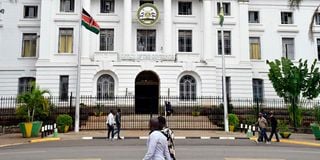Senators probe loss of billions through county revenue systems

Members of the public walk past the entrance to City Hall in Nairobi on April 19, 2024.
What you need to know:
- Senate County Public Accounts Committee (CPAC) Chairperson, Moses Kajwang’, said the committee will this month commence an inquiry into City Hall’s OSR systems and their governance structures.
- The Homa Bay Senator said the move has been necessitated by concerns that the Governor Johnson Sakaja-led county government is running a porous revenue collection system with backdoors where what is reported as collected revenue is not necessarily what has been collected.
A Parliamentary committee will open investigations into own source revenue (OSR) systems used by counties amid reports of losses running into billions.
Counties have consistently failed to meet their revenue targets since the start of devolution in 2013, with systems that abet theft and leakages blamed for heavy losses.
Although counties have the potential to collect Sh260 billion annually, they have only managed a fraction, with only a paltry Sh28.94 billion netted in the first nine months of the 2022/23 financial year.
The probe will begin with Nairobi County.
Senate County Public Accounts Committee (CPAC) Chairperson, Moses Kajwang’, said the committee will this month commence an inquiry into City Hall’s OSR systems and their governance structures.
The Homa Bay Senator said the move has been necessitated by concerns that the Governor Johnson Sakaja-led county government is running a porous revenue collection system with backdoors where what is reported as collected revenue is not necessarily what has been collected.
“What the county government is reporting as revenue collected is not proportional to the commercial and economic activities in the capital city,” said Mr Kajwang’.
The latest development comes a month after a 13-member ad hoc committee established by the Nairobi County Assembly to investigate alleged mismanagement of Nairobi City County revenues failed to release its report, five months after completing its work.
The committee was, among other issues, looking into the ownership of the Nairobi Revenue Service (NRS), an entity the defunct Nairobi Metropolitan Service (NMS) used to collect revenue in the city.
However, the mystery continues to shroud the shelving of plans to table the report of the committee that was chaired by Majority Leader Peter Imwatok.
The Makongeni Ward MCA had accused the county executive of meddling in the work of the committee.
In one instance during the hearings, Mr Imwatok termed what would come out of the report as “damning revelations” that would for once “get rid” of the rot in revenue collection at City Hall.
Senator Kajwang’ said the committee has been inviting the governor for a discussion on the receiver of revenue report by Auditor-General Nancy Gathungu and has also given time to MCAs to conduct an inquiry into the systems used in Nairobi County.
“Unfortunately, we are hearing stories that the report has been shelved and is not getting the attention it deserves,” said Mr Kajwang’.
“We shall not interfere with the processes of the county assembly, but within this month and October, this committee will call the county alongside a few other counties for a conversation on the true potential of their source revenue and the issue of systems,” he added.
He pointed out that the watchdog committee has established that whereas automation can bring efficiency, it can also be a problem and can be grossly abused by counties.
The CPAC chairperson said it is the responsibility of the National Treasury to design and prescribe a financial management system for county governments, including their OSR systems, for devolved units to have a standardised revenue collection system.
“The same way they provided Ifmis and IPPD and as well as Laifoms, it is time we have a conversation on a standardised source of revenue for all county governments. This is something that we need to push and if we push it, we shall see a gradual increase in what is collected,” he said.
Last week, members of the Senate Committee on County Public Investment and Special Funds asked Ms Gathungu to audit external revenue collection firms contracted by counties to collect local revenue following concerns over the accuracy of revenue figures declared by the service providers.
The lawmakers raised concerns over the lack of auditing of the revenue service providers, saying the gap has opened a loophole where the companies siphon billions of shillings from the devolved units.
The move follows new revelations of fraudulent schemes perpetrated by governors and senior county officials, where contracts to procure the systems are designed to loot public funds.
A June 2022 report by the Commission on Revenue Allocation (CRA) revealed that county governments have the potential to collect up to Sh216 billion in revenue from their key revenue streams.
The report, Comprehensive Own Source Revenue Potential and Tax Gap Study of County Governments, showed that all 47 county governments can generate nearly seven times more than they currently realise in OSR.
According to audited data on actual revenue collections, the counties generated around Sh38 billion annually on average from their revenue sources over the last three financial years between 2017 and 2020.
The devolved units have consistently failed to meet their OSR targets in all the fiscal years since the start of devolution, revealing untapped revenue sources in the counties.
In the fiscal year ending June 30, 2021, the devolved units generated Sh31 billion against a target of Sh54.3 billion, leaving room for substantial improvements in revenue generation.
Nairobi County has been collecting an average of Sh9.5 billion in local revenues over the last three financial years, while its potential is estimated at more than Sh25 billion.
In the fiscal year ending June 30, 2024, the county government collected local revenue of Sh12.8 billion, the highest-ever collection for the county government.
However, the figure is a staggering Sh7.26 billion off the target of Sh20.06 billion projected by the devolved unit.
According to the CRA report, Kiambu, Nakuru, and Mombasa are the three counties with the largest revenue potential after Nairobi City, able to generate Sh5.2 billion, 4.5 billion, and 4.4 billion per year, respectively.
The estimated annual revenue potential for Machakos, Narok, Kisumu, and Meru is over Sh2.3 billion each.
Meru County’s potential is around Sh3.2 billion annually but it only collects 20 percent of the revenues it could potentially generate if it operated in line with top-performing county governments.





